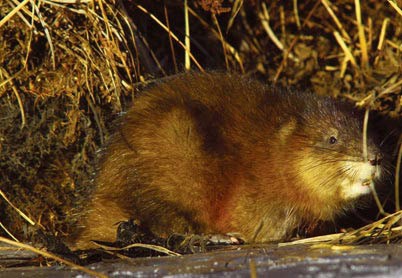Hidden in cattails, I was hoping to photograph moose feeding in a nearby cove. Suddenly a V-shaped wake appeared in the water and a muskrat swam vigorously towards me. The creature resembled an oversized meadow vole, yet acted more like a tiny beaver. At its stern, the muskrat’s scaly, long rudder-like tail enabled the animal to swim and steer with remarkable finesse.
The muskrat, Ondatra zibethicus, is the largest and most specialized of the arvioline rodents – a subfamily that includes voles, lemmings, and meadow mice. Physical adaptations for a semiaquatic lifestyle, coupled with considerable dietary and denning-habitat flexibility, allow the muskrat to thrive in aquatic environments across most of North America. Ponds, lakes, slow-moving rivers and streams, open swamps, sloughs, fresh and saltwater marshes – even farm ponds and irrigation ditches – are all used by the resourceful muskrat.
Muskrat tracks and their various structures are often easy to find. Smaller front foot tracks show four slender toes, each of which culminates in a clear nail impression. A fifth rudimentary toenail may or may not register. Larger hind feet leave five asymmetrically arranged stouter-looking toes, with the two outer toes pointing out to the side. Stiff hairs fringe each toe and may leave an outer impression encircling the actual toe impression. Don’t expect to see evidence of the “partial webbing” that is described in nearly all tracking guides. Unlike the middle or “distal” web impressions one can readily find in otter or beaver tracks, respectively, the muskrat’s proximal webbing (meaning close to the body) is analogous to the minimal webbing that exists between our fingers, and it does not register in tracks. My favorite feature to look for is the worm-like pattern of horizontal creases that are present on the naked toes of both front and hind feet. Tail drag marks are often visible in an “s”-like pattern between the right and left foot tracks.
Bank burrows, houses, push-ups, and feeders are evidence of muskrats in residence. Muskrats excavate extensive and elaborate tunnel and denning chamber systems into suitable bank side environments. Underwater entryways provide secure access to several above-water denning spaces. Dome-shaped houses resemble much larger beaver lodges, except that they are made of piled stems and leaves of emergent vegetation and other materials, including cattails, sedges, rushes, grass, mosses, water-soaked leaves, bottom debris, and mud.
Feeder huts, or feeders, resemble houses, but are smaller. Feeders provide safe, warm structures into which food is carried for consumption. Push-ups are piles of vegetation and other materials that a muskrat gathers from beneath the water and pushes upward through a hole or crack in the ice. Once frozen in place, these structures both conceal and protect muskrats as they surface from beneath the ice to breathe.
Finally, feeding platforms are simply floating piles of vegetation. Here, muskrats sun themselves and rest. Dozens of other animals, including waterfowl and other birds, turtles, snakes, frogs, spiders and other insects, and mammals similarly use these platforms to rest, bask, nest, and even hunt.


